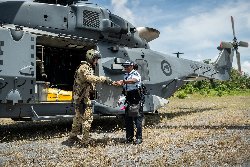Cablegate: Overcrowding Critical Challenge for Tanzanian Prisons
VZCZCXRO7961
RR RUEHBZ RUEHDU RUEHJO RUEHMR RUEHRN
DE RUEHDR #0026/01 0141252
ZNR UUUUU ZZH
R 141252Z JAN 10
FM AMEMBASSY DAR ES SALAAM
TO RUEHC/SECSTATE WASHDC 9212
INFO RUCNSAD/SOUTHERN AF DEVELOPMENT COMMUNITY COLLECTIVE
RUEHJB/AMEMBASSY BUJUMBURA 3066
RUEHKM/AMEMBASSY KAMPALA 0039
RUEHLGB/AMEMBASSY KIGALI 1542
RUEHNR/AMEMBASSY NAIROBI 1508
UNCLAS SECTION 01 OF 03 DAR ES SALAAM 000026
SENSITIVE
SIPDIS
DEPARTMENT FOR AF/E JTREADWELL, INR FEHRENREICH
E.O. 12958: N/A
TAGS: ASEC CASC PGOV PHUM TZ
SUBJECT: OVERCROWDING CRITICAL CHALLENGE FOR TANZANIAN PRISONS
1. (SBU) SUMMARY: Severe overcrowding produces poor living
conditions in Dar es Salaam's prisons. Our observations indicate
food supplies are sufficient, while sanitary and sleeping facilities
are clearly inadequate. Remand prisoners at the Segerea Prison, who
may wait up to five years for a trial, have limited recreational
opportunities, often spending whole days exposed to the hot sun in a
cramped court yard. While convicted prisoners at the Ukonga Prison
may participate in an apprenticeship program, they too are subject
to harsh conditions compounded by overcrowding. The Chief Justice
and Director of Public Prosecution are taking steps to speed up the
judicial process; however, these initiatives will not significantly
reduce overcrowding in the near term. END SUMMARY
2. (SBU) On December 18, 2009, Embassy staff from the Consular and
Political Sections as well as the Regional Security Office visited
Segerea and Ukonga prisons in Dar es Salaam. There are four prisons
in Dar es Salaam, of which three, including Ukonga and Segerea, are
maximum security. Fewer than 5,000 prisoners are held in these
facilities, but more than 50 percent are remand prisoners. Segerea
Prison is the primary facility for suspects awaiting trial. These
prisons employ more than 1,300 staff members.
3. (SBU) The Deputy Chief of Prisons (DCP), Dr. Salum Chambuso, and
the Regional Prisons Officer for Dar es Salaam, Cleophace Rweye,
briefed the Embassy delegation at Segerea, and then guided the
delegation on a tour of both facilities. The officials presented a
credible view of prison conditions (although the facilities were
suspiciously clean). They provided access to the entire facility
and answered questions frankly. They generally noted deficiencies.
SEGEREA PRISON: INTOLERABLE OVERCROWDING
----------------------------------------
4. (SBU) Segerea Prison holds 1,867 inmates, including 143 juveniles
and 136 women held in separate wings of the facility, as well as 11
illegal immigrants (primarily from Bangladesh). (Note: The DCP
insisted that all relevant protocols had been followed and the
appropriate foreign country officials notified of the presence of
these migrants.) The facility is secured with a padlock, attached
to a solid wood door. The guards announced and manually recorded
the number of prisoners in the prison each time the door was opened.
Several guards were standing at the prison door and others were in
the lock up facility guarding the prisoners. Prison officials
insisted the ratio of guards to prisoners was one to five but even
on the day of the delegationQs visit, when security may have been
heightened, the ratio was visibly higher.
5. (SBU) When the delegation entered the juvenile section, the
inmates sat in an unprotected courtyard in an orderly, yet cramped
fashion. This space, where the juveniles spend most of their time,
offered little shelter from the hot sun or space for recreational
activities. Most wore tattered civilian clothing, reflecting their
status as remand prisoners. Although primarily a remand facility,
Segerea holds a number of convicted juvenile prisoners, identified
by the standard issue orange uniforms. Remand prisoners depend on
family members to provide clothing. Delegation members asked how
long on average the juveniles waited for their trials. The ACP
queried a handful of remand prisoners about the duration of their
stay. The majority had been there less than a year, but one remand
prisoner from Uganda had been waiting for his murder trial for five
years.
6. (SBU) Entering the men's wing, the delegation found more than
1,200 prisoners crowded into a small courtyard (roughly the size of
a tennis court), with little to entertain them except the visiting
diplomats. Although the prisoners could have overpowered the
weaponless guards, they complied with orders to remain seated and
were surprisingly subdued. The prisoners did not seem interested in
physically challenging the guards. (Note: Guards at the prison
carry batons, not firearms.)
7. (SBU) In any 24 hour period, these inmates spend twelve hours in
the small courtyard, fully exposed to the sun and rain. Their
remaining time is spent locked up in cells. Each cell is built to
hold 51 prisoners but due to overcrowding more than 175 prisoners
share the space. Thin blue mattresses covered the floor in neat
rows with little room between them. Three prisoners share every two
mattresses. There were no mosquito nets to guard against malaria.
8. (SBU) Each cell had two squat toilets, flushed using buckets of
water. Given the number of men sharing these two toilets, they were
certainly inadequate and likely unsanitary when not cleaned for the
benefit of visitors. (Note: In May, CHRAGG investigated a report
that inmates at another prison were denied access to toilets. The
DAR ES SAL 00000026 002 OF 003
results of this investigation have yet to be released. NGOs have
also reported that sanitary conditions in Tanzanian prisons are poor
and contribute to the spread of disease. End Note.) Each cell had
one shower facility, which did not appear to have a working
showerhead, located in close proximity to the toilets. As with the
juveniles, many of the adult remand prisoners appeared to be wearing
the same clothes in which they had arrived at the prison, now
tattered and soiled.
9. (SBU) The women's wing of the prison was in much better
condition. The women's cells were equipped with beds, the majority
of which had mosquito nets. There was a sheltered outdoor area as
well as an open courtyard with sink-like facility. The women's wing
is a mixed facility, holding 40 convicted prisoners and 94 remand
prisoners. Ten children live with their mothers in the prison and
are allowed to do so until age ten. With children being passed from
one woman to another, there seemed to be some sense of community
among the inmates.
10. (SBU) Both the women's and the men's wings of the prison had a
small clinic for primary care purposes. The men's clinic had twenty
beds and the women's ten. Eight male patients were receiving
treatment in their clinic for malaria and non-life threatening
injuries received during arrest. The women's clinic was empty and
cleaner than the men's. The prison has one doctor, one clinical
specialist, and three or four nurses on staff. Officials purchase
drugs through the government tender system and, according to the
DCP; they are available in sufficient quantities to treat the
prisoners. The most common illnesses are TB, malaria, and
pneumonia. Patients in serious condition are referred to local
hospitals.
11. (SBU) The "kitchen" at Segerea Prison, an open tin-roofed
facility, contained several large vats of thick porridge and beans,
which was the day's meal. Inmates are fed one main meal per day
which officials assured EmbOffs contained the necessary daily
caloric intake. HIV positive inmates receive three meals a day.
While the porridge was bland, delegation members agreed after a
taste that it was edible. The officials said that inmates receive
rice, vegetables, and meat once a week as well as sardines and
fruits twice a week. This allocation of food is standard across all
prisons in Tanzania. (Note: While the food seemed to be plentiful on
the day of the delegationQs visit, NGOs and the media have reported
receiving complaints about inadequate supplies of food. End Note)
12. (SBU) The DCP stated the prison had running water, but the
delegation saw large vats of water scattered about the compound that
suggested this was not always the case. Officials said that the
water comes from bore holes and wells, but they trucked in water
when this supply was inadequate. (Note: NGOs as well as the
Commission for Human Rights and Good Governance (CHRAGG) have
reported that water resources are insufficient at a number of
prisons. End Note)
UKONGA PRISON: OVERCROWDED CELLS, SHARP OBJECTS, LITTLE VIOLENCE
--------------------------------------------
13. (SBU) The Ukonga maximum security prison faces similar
challenges to the Segerea facility. Built for roughly 900 inmates,
Ukonga holds more than 2,000 inmates. The cells are overcrowded and
combined with poor sanitation, encourage the spread of disease.
However, the expansive prison grounds provide adequate space for
recreational activities such as soccer and bao, a local board game.
There is an extensive vocational training program at the Ukonga
prison. More than 1,000 long-term prisoners are trained to work as
carpenters, tailors, upholsterers, or weavers. The goods made at
the prison are sold locally. In addition to the workshops, the
Ukonga prison has started a biogas project. Waste from the toilet
facilities is diverted to a holding tank from which the gas is
captured and used for cooking. Human waste provides fertilizer for
the prison's crops.
14. (SBU) The officials pointed out that neither the kitchen
facility nor the health center at the prison were finished. Prison
labor is used to build all facilities at the prison but funds are
needed to cover other costs. The officials lamented the fact that
resources were not available to finish the HIV and TB screening
center, originally supported by the Clinton Foundation. HIV
screening is voluntary, but the DCP said many prisoners choose to be
tested. Asked why HIV screening was not mandatory, the DCP said
they were concerned that HIV negative inmates who tested positive
upon completing their sentences would sue the government. (Comment:
Such an eventuality seems highly unlikely, but the comment is in
keeping with the DCP's other odd remarks about HIV. He suggested
that inmates wanted to be HIV positive in order to receive three
meals a day. End Comment)
DAR ES SAL 00000026 003 OF 003
15. (SBU) One of the prison doctors joined us on the tour at Ukonga.
He said the facility had three doctors and ten nurses. He
contradicted the DCP, stating that the quantity of drugs received
was insufficient to meet demand. Although inmates are allowed to
receive medications from family members, he said they had to get
special permission from prison officials.
16. (SBU) While Ukonga prison was a larger facility, providing
inmates with more space outside their cells, to an outsider the
security situation seemed no less precarious than at Segerea.
Inmates have access to all manner of sharp objects in the workshops.
In addition, there were large shards of glass on the ground. As at
Segerea, however, neither the guards nor the inmates seemed
interested or alarmed about these potential weapons. Asked about
violence in the prisons, the officials said they had the occasional
incident but did not have any problems with gangs.
17. (SBU) COMMENT: Tanzanians have a well-earned reputation for
abhorring violence. The country has never experienced widespread
violence or unconstitutional changes of government. We expected
that the presumed criminals making up the prison population would be
an exception to the general rule of Tanzanian peacefulness.
Overcrowding in some American prisons contributes to significant
rates of prison violence. However, our observations and discussions
with officials indicate that this is not a major issue in Tanzanian
prisons.
18. (U) The DCP noted on a number of occasions that the prison
system "respects the human rights of the prisoners.Q He blamed both
financial constraints and the sluggish court system, which takes
anywhere from two to five years to hear a case. He took advantage
of the visit to suggest that the USG might be interested in
financing several of their expansion projects to address
overcrowding. From a human rights perspective, overcrowding in the
prisons the delegation visited were worrisome and would likely be
hazardous for any incarcerated American citizen. (Note: At the time
of the visit, there were no known U.S. citizens incarcerated in
Tanzania.) The government has taken steps to ease overcrowding. In
2009, President Kikwete pardoned more than 7,000 prisoners.
Additionally, the Chief Justice and the Director of Public
Prosecution endeavored to speed up the judicial process by
realigning human resources, resolving cases through plea bargains,
and implementing an electronic case management system. These
efforts will not reduce overcrowding significantly in the short
term.
LENHARDT


 UN News: Healing Page By Page In Earthquake-affected Türkiye
UN News: Healing Page By Page In Earthquake-affected Türkiye Save The Children: Rate Of Attacks On Healthcare in Gaza Higher Than In Any Other Conflict Since 2018
Save The Children: Rate Of Attacks On Healthcare in Gaza Higher Than In Any Other Conflict Since 2018 UN News: Green Light For New Cholera Vaccine, Ukraine Attacks Condemned, Action Against Racism
UN News: Green Light For New Cholera Vaccine, Ukraine Attacks Condemned, Action Against Racism Laureus: Grand Slam Champion Garbiñe Muguruza Announces Retirement Ahead Of Laureus World Sports Awards
Laureus: Grand Slam Champion Garbiñe Muguruza Announces Retirement Ahead Of Laureus World Sports Awards Carbon Market Watch: Going For Green - Is The Paris Olympics Winning The Race Against The Climate Clock?
Carbon Market Watch: Going For Green - Is The Paris Olympics Winning The Race Against The Climate Clock? New Zealand Defence Force: NZDF Working With Pacific Neighbours To Support Solomon Islands Election
New Zealand Defence Force: NZDF Working With Pacific Neighbours To Support Solomon Islands Election